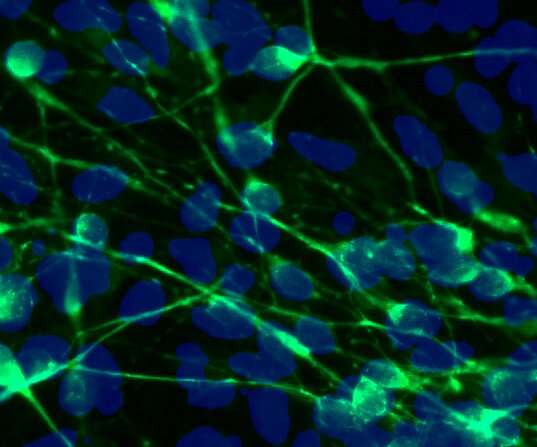Altered potassium levels in neurons may cause mood swings in bipolar disorder

People with bipolar disorder experience dramatic shifts in mood, oscillating between often debilitating periods of mania and depression. While a third of people with bipolar disorder can be successfully treated with the drug lithium, the majority of patients struggle to find treatment options that work.
Now, a sweeping new set of findings by Salk researchers reveals previously unknown details explaining why some neurons in bipolar patients swing between being overly or under excited. In two papers published in the journal Biological Psychiatry in February 2020 and October 2019, Salk researchers used experimental and computational techniques to describe how variations in potassium and sodium currents in the brain cells of people with bipolar disorder may help to further explain why some patients respond to lithium and others do not.
"This is exciting progress toward understanding the cellular mechanisms that cause bipolar disorder," says Salk Professor Rusty Gage, the study's senior author and president of the Institute. "It also brings us one step closer to being able to develop new therapeutics to treat the disorder."
In 2015, Gage and his colleagues discovered for the first time the initial differences between brain cells of patients who respond to lithium and those who don't. In both cases, neurons from the brain's dentate gyrus (DG) region were hyperexcitable—more easily stimulated—compared to DG neurons from people without bipolar disorder. But when exposed to lithium, only the cells from known lithium-responders were calmed by the drug.
In the new research, Gage's team—curious whether the results held true across different brain areas—conducted similar experiments but with more in-depth probes and using a different type of neuron than before. They grew the neurons—called CA3 pyramidal neurons—from six people with bipolar disorder, three of whom responded to lithium.
While in previous studies DG neurons from all bipolar patients were hyperexcitable, in the new study, only CA3 neurons from lithium responders were hyperexcitable all the time.
"The neurons were very different between responders and non-responders," says Salk research associate Shani Stern, first author of both papers. "It's almost as if it's two different diseases."
Studying the CA3 neurons from lithium responders more closely, the team found that these cells had higher than usual numbers of potassium channels as well as stronger potassium currents through these channels. The increased potassium currents, the scientists showed, were responsible for the hyperactivity of the CA3 neurons: when they exposed the cells to a potassium channel blocker, the hyperactivity disappeared. Intriguingly, when they exposed the cells to lithium, the drug not only reversed the hyperactivity but reduced potassium currents at the same time.
In addition, the team initially observed that the CA3 neurons from lithium non-responders, on average, had normal excitability. But when they looked more closely at individual cells over time, they found a different story.
"There were days I'd measure the cells and the whole group would be hyperexcitable, and other days they'd all be hypoexcitable," says Stern. "And then there were times when the cells would be split; some would be very hyperexcitable and others very hypoexcitable."
To better understand what was causing these fluctuations, the researchers designed a computational simulation of CA3 neuron activity. The computer simulation revealed that drastic reductions in sodium currents and an increase in the amplitude of potassium currents could lead to the same kind of neuronal instability in CA3 neurons—explaining both hyperexcitability and hypoexcitability. When the researchers then exposed CA3 neurons from non-responders to potassium channel blockers, their excitability became closer to control levels. The findings strengthened the case that potassium currents play a role in bipolar disorder—in both lithium responders and non-responders—and can help researchers understand how to better target drugs.
The team is planning additional studies on what happens to large networks of neurons when they alternate between hyperexcitable and hypoexcitable phases to understand if these shifts may be driving the manic and depressive moods seen in bipolar disorder.
More information: Shani Stern et al, Mechanisms Underlying the Hyperexcitability of CA3 and Dentate Gyrus Hippocampal Neurons Derived From Patients With Bipolar Disorder, Biological Psychiatry (2019). DOI: 10.1016/j.biopsych.2019.09.018



















